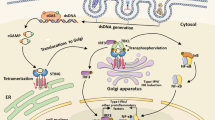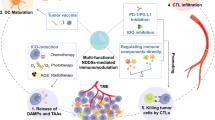Abstract
Cancer immunotherapy has made significant progress in the last few decades, revolutionizing oncology. However, low patient response rates and potential immune-related adverse events continue to be major clinical challenges. Cancer nanomedicine, by virtue of its regulated delivery and modular flexibility, has shown the potential to strengthen antitumor immune responses and sensitize tumors to immunotherapy. In this study, we developed tumor microenvironment (TME) responsive nanomedicine to achieve specific and localized amplification of the immune response in tumor tissue in a safe and effective manner, while simultaneously reducing immune-related side effects. We synthesized the TME responsive prodrug by coupling MSA-2, a stimulator of interferon genes (STING) agonist, and NLG-919, an indoleamine 2,3 dioxygenase (IDO) inhibitor. The prodrug was assembled into nanoparticles to enhance the solubility and bioavailability. By synthesizing a TME responsive prodrug, we aim to explore the therapeutic efficacy of combined regimen (STING agonist and IDO inhibitor) for cancer, and reduce the unwanted side effects of STING agonism on normal tissues. Free prodrug and nanoparticles were characterized by mass spectrometry, dynamic light scattering (DLS), and transmission electron microscopy (TEM). Following that, we investigated the tumor accumulation, anti-tumor activity, and toxicity in vitro and in vivo. Prodrug nanoparticles demonstrated the ability to inhibit the tumor growth and activate antitumor immune response by modulating immune cells populations in tumor microenvironment. The TME responsive nanomedicine provided an effective tool for precise targeting, promoting antitumor immunity, and efficient tumor growth inhibition with safety. Outcomes of this study may have implications for future clinical trials.

Similar content being viewed by others
References
Couzin-Frankel, J. Breakthrough of the year 2013. Cancer immunotherapy. Science 2013, 342, 1432–1433.
Postow, M. A.; Callahan, M. K.; Wolchok, J. D. Immune checkpoint blockade in cancer therapy. J. Clin. Oncol. 2015, 33, 1974–1982.
Buchbinder, E. I.; Hodi, F. S. Immune-checkpoint blockade—Durable cancer control. Nat. Rev. Clin. Oncol. 2016, 13, 77–78.
Sanmamed, M. F.; Chen, L. P. A paradigm shift in cancer immunotherapy: From enhancement to normalization. Cell 2019, 176, 677.
Riley, R. S.; June, C. H.; Langer, R.; Mitchell, M. J. Delivery technologies for cancer immunotherapy. Nat. Rev. Drug Discov. 2019, 18, 175–196.
Phuengkham, H.; Ren, L.; Shin, I. W.; Lim, Y. T. Nanoengineered immune niches for reprogramming the immunosuppressive tumor microenvironment and enhancing cancer immunotherapy. Adv. Mater. 2019, 31, e1803322.
Ahmad, S. M.; Borch, T. H.; Hansen, M.; Andersen, M. H. PD-L1-specific T cells. Cancer Immunol. Immunother. 2016, 65, 797–804.
Blank, C.; Mackensen, A. Contribution of the PD-L1/PD-1 pathway to T-cell exhaustion: An update on implications for chronic infections and tumor evasion. Cancer Immunol. Immunother. 2007, 56, 739–745.
Moy, A. J.; Tunnell, J. W. Combinatorial immunotherapy and nanoparticle mediated hyperthermia. Adv. Drug Deliv. Rev. 2017, 114, 175–183.
Chen, Q.; Xu, L. G.; Liang, C.; Wang, C.; Peng, R.; Liu, Z. Photothermal therapy with immune-adjuvant nanoparticles together with checkpoint blockade for effective cancer immunotherapy. Nat. Commun. 2016, 7, 13193.
Peng, J. R.; Yang, Q.; Xiao, Y.; Shi, K.; Liu, Q. Y.; Hao, Y.; Yang, F.; Han, R. X.; Qian, Z. Y. Tumor microenvironment responsive drug-dye-peptide nanoassembly for enhanced tumor-targeting, penetration, and photo-chemo-immunotherapy. Adv. Funct. Mater. 2019, 29, 1900004.
Qin, S. Y.; Cheng, Y. J.; Lei, Q.; Zhang, A. Q.; Zhang, X. Z. Combinational strategy for high-performance cancer chemotherapy. Biomaterials 2018, 171, 178–197.
Muller, A. J.; Manfredi, M. G.; Zakharia, Y.; Prendergast, G. C. Inhibiting IDO pathways to treat cancer: Lessons from the ECHO-301 trial and beyond. Semin. Immunopathol. 2019, 41, 41–48.
Peng, J. R.; Xiao, Y.; Li, W. T.; Yang, Q.; Tan, L. W.; Jia, Y. P.; Qu, Y.; Qian, Z. Y. Photosensitizer micelles together with IDO inhibitor enhance cancer photothermal therapy and immunotherapy. Adv. Sci. 2018, 5, 1700891.
Yan, M. M.; Liu, Y. J.; Zhu, X. H.; Wang, X. L.; Liu, L. X.; Sun, H. F.; Wang, C.; Kong, D. L.; Ma, G. L. Nanoscale reduced graphene oxide-mediated photothermal therapy together with IDO inhibition and PD-L1 blockade synergistically promote antitumor immunity. ACS Appl. Mater. Interfaces 2019, 11, 1876–1885.
Liu, D. C.; Chen, B. L.; Mo, Y. L.; Wang, Z. H.; Qi, T.; Zhang, Q.; Wang, Y. G. Redox-activated porphyrin-based liposome remote-loaded with indoleamine 2,3-dioxygenase (IDO) inhibitor for synergistic photoimmunotherapy through induction of immunogenic cell death and blockage of IDO pathway. Nano Lett. 2019, 19, 6964–6976.
Xing, L.; Gong, J. H.; Wang, Y.; Zhu, Y.; Huang, Z. J.; Zhao, J.; Li, F.; Wang, J. H.; Wen, H.; Jiang, H. L. Hypoxia alleviation-triggered enhanced photodynamic therapy in combination with IDO inhibitor for preferable cancer therapy. Biomaterials 2019, 206, 170–182.
Long, G. V.; Dummer, R.; Hamid, O.; Gajewski, T. F.; Caglevic, C.; Dalle, S.; Arance, A.; Carlino, M. S.; Grob, J. J.; Kim, T. M. et al. Epacadostat plus pembrolizumab versus placebo plus pembrolizumab in patients with unresectable or metastatic melanoma (ECHO-301/KEYNOTE-252): A phase 3, randomised, double-blind study. Lancet Oncol. 2019, 20, 1083–1097.
Chandra, D.; Quispe-Tintaya, W.; Jahangir, A.; Asafu-Adjei, D.; Ramos, I.; Sintim, H. O.; Zhou, J.; Hayakawa, Y.; Karaolis, D. K.; Gravekamp, C. STING ligand c-di-GMP improves cancer vaccination against metastatic breast cancer. Cancer Immunol. Res. 2014, 2, 901–910.
Jing, W. Q.; McAllister, D.; Vonderhaar, E. P.; Palen, K.; Riese, M. J.; Gershan, J.; Johnson, B. D.; Dwinell, M. B. STING agonist inflames the pancreatic cancer immune microenvironment and reduces tumor burden in mouse models. J. Immunother. Cancer 2019, 7, 115.
Sen, T.; Rodriguez, B. L.; Chen, L.; Della Corte, C. M.; Morikawa, N.; Fujimoto, J.; Cristea, S.; Nguyen, T.; Diao, L. X.; Li, L. R. et al. Targeting DNA damage response promotes antitumor immunity through STING-mediated T-cell activation in small cell lung cancer. Cancer Discov. 2019, 9, 646–661.
Yang, H.; Lee, W. S.; Kong, S. J.; Kim, C. G.; Kim, J. H.; Chang, S. K.; Kim, S.; Kim, G.; Chon, H. J.; Kim, C. STING activation reprograms tumor vasculatures and synergizes with VEGFR2 blockade. J. Clin. Invest. 2019, 129, 4350–4364.
Demaria, O.; De Gassart, A.; Coso, S.; Gestermann, N.; Di Domizio, J.; Flatz, L.; Gaide, O.; Michielin, O.; Hwu, P.; Petrova, T. V. et al. STING activation of tumor endothelial cells initiates spontaneous and therapeutic antitumor immunity. Proc. Natl. Acad. Sci. USA 2015, 112, 15408–15413.
Ager, C. R.; Reilley, M. J.; Nicholas, C.; Bartkowiak, T.; Jaiswal, A. R.; Curran, M. A. Intratumoral STING activation with T-cell checkpoint modulation generates systemic antitumor immunity. Cancer Immunol. Res. 2017, 5, 676–684.
Ghaffari, A.; Peterson, N.; Khalaj, K.; Vitkin, N.; Robinson, A.; Francis, J. A.; Koti, M. STING agonist therapy in combination with PD-1 immune checkpoint blockade enhances response to carboplatin chemotherapy in high-grade serous ovarian cancer. Br. J. Cancer 2018, 119, 440–449.
Lemos, H.; Mohamed, E.; Huang, L.; Ou, R.; Pacholczyk, G.; Arbab, A. S.; Munn, D.; Mellor, A. L. STING promotes the growth of tumors characterized by low antigenicity via IDO activation. Cancer Res. 2016, 76, 2076–2081.
Munn, D. H.; Mellor, A. L. IDO in the tumor microenvironment: Inflammation, counter-regulation, and tolerance. Trends Immunol. 2016, 37, 193–207.
Prendergast, G. C.; Malachowski, W. P.; DuHadaway, J. B.; Muller, A. J. Discovery of IDO1 inhibitors: From bench to bedside. Cancer Res. 2017, 77, 6795–6811.
Shi, J. Q.; Liu, C. Q.; Luo, S. N.; Cao, T. Y.; Lin, B. L.; Zhou, M.; Zhang, X.; Wang, S.; Zheng, T. S.; Li, X. B. STING agonist and IDO inhibitor combination therapy inhibits tumor progression in murine models of colorectal cancer. Cell Immunol. 2021, 366, 104384.
Pan, B. S.; Perera, S. A.; Piesvaux, J. A.; Presland, J. P.; Schroeder, G. K.; Cumming, J. N.; Trotter, B. W.; Altman, M. D.; Buevich, A. V.; Cash, B. et al. An orally available non-nucleotide STING agonist with antitumor activity. Science 2020, 369, eaba6098.
Ashok, B.; Arleth, L.; Hjelm, R. P.; Rubinstein, I.; Önyüksel, H. In vitro characterization of PEGylated phospholipid micelles for improved drug solubilization: Effects of PEG chain length and PC incorporation. J. Pharm. Sci. 2004, 93, 2476–2487.
Vuković, L.; Khatib, F. A.; Drake, S. P.; Madriaga, A.; Brandenburg, K. S.; Král, P.; Onyuksel, H. Structure and dynamics of highly PEG-ylated sterically stabilized micelles in aqueous media. J. Am. Chem. Soc. 2011, 133, 13481–13488.
Trubetskoy, V. S.; Torchilin, V. P. Use of polyoxyethylene-lipid conjugates as long-circulating carriers for delivery of therapeutic and diagnostic agents. Adv. Drug Deliv. Rev. 1995, 16, 311–320.
Maeda, H.; Wu, J.; Sawa, T.; Matsumura, Y.; Hori, K. Tumor vascular permeability and the EPR effect in macromolecular therapeutics: A review. J. Control. Release 2000, 65, 271–284.
Shen, F. Y.; Feng, L. Z.; Zhu, Y. J.; Tao, D. L.; Xu, J.; Peng, R.; Liu, Z. Oxaliplatin-/NLG919 prodrugs-constructed liposomes for effective chemo-immunotherapy of colorectal cancer. Biomaterials 2020, 255, 120190.
Li, A. P.; Yi, M.; Qin, S.; Song, Y. P.; Chu, Q.; Wu, K. M. Activating cGAS-STING pathway for the optimal effect of cancer immunotherapy. J. Hematol. Oncol. 2019, 12, 35.
Ye, Z. X.; Yue, L. X.; Shi, J. C.; Shao, M. M.; Wu, T. Role of IDO and TDO in cancers and related diseases and the therapeutic implications. J. Cancer 2019, 10, 2771–2782.
Goldberg, M. S. Improving cancer immunotherapy through nanotechnology. Nat. Rev. Cancer 2019, 19, 587–602.
Chon, H. J.; Kim, H.; Noh, J. H.; Yang, H.; Lee, W. S.; Kong, S. J.; Lee, S. J.; Lee, Y. S.; Kim, W. R.; Kim, J. H. et al. STING signaling is a potential immunotherapeutic target in colorectal cancer. J. Cancer 2019, 10, 4932–4938.
Liang, H.; Deng, L. F.; Hou, Y. Z.; Meng, X. J.; Huang, X. N.; Rao, E. Y.; Zheng, W. X.; Mauceri, H.; Mack, M.; Xu, M. et al. Host STING-dependent MDSC mobilization drives extrinsic radiation resistance. Nat. Commun. 2017, 8, 1736.
Woo, S. R.; Fuertes, M. B.; Corrales, L.; Spranger, S.; Furdyna, M. J.; Leung, M. Y. K.; Duggan, R.; Wang, Y.; Barber, G. N.; Fitzgerald, K. A. et al. STING-dependent cytosolic DNA sensing mediates innate immune recognition of immunogenic tumors. Immunity 2014, 41, 830–842.
Prendergast, G. C.; Malachowski, W. J.; Mondal, A.; Scherle, P.; Muller, A. J. Indoleamine 2,3-dioxygenase and its therapeutic inhibition in cancer. Int. Rev. Cell Mol. Biol. 2018, 336, 175–203.
Li, A. L.; Barsoumian, H. B.; Schoenhals, J. E.; Cushman, T. R.; Caetano, M. S.; Wang, X. H.; Valdecanas, D. R.; Niknam, S.; Younes, A. I.; Li, G. et al. Indoleamine 2,3-dioxygenase 1 inhibition targets anti-PD1-resistant lung tumors by blocking myeloid-derived suppressor cells. Cancer Lett. 2018, 431, 54–63.
Acknowledgments
This work was supported by the National Natural Science Foundation of China (Nos. 81920108001 and 81870007) and Zhejiang Provincial Program for the Cultivation of High-Level Innovative Health Talents.
Author information
Authors and Affiliations
Corresponding authors
Electronic Supplementary Material
Rights and permissions
About this article
Cite this article
Syeda, M.Z., Hong, T., Zhang, M. et al. A prodrug nanoplatform via esterification of STING agonist and IDO inhibitor for synergistic cancer immunotherapy. Nano Res. 15, 9215–9222 (2022). https://doi.org/10.1007/s12274-022-4598-6
Received:
Revised:
Accepted:
Published:
Issue Date:
DOI: https://doi.org/10.1007/s12274-022-4598-6




